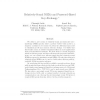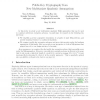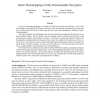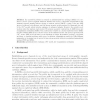106
Voted
PKC
2012
Springer
13 years 3 months ago
2012
Springer
We define a new notion of relatively-sound non-interactive zeroknowledge (NIZK) proofs, where a private verifier with access to a trapdoor continues to be sound even when the Ad...
150
click to vote
PKC
2012
Springer
13 years 3 months ago
2012
Springer
We initiate the study of security for key-dependent messages (KDM), sometimes also known as “circular” or “clique” security, in the setting of identity-based encryption (I...
125
click to vote
PKC
2012
Springer
13 years 3 months ago
2012
Springer
ded abstract of this work will appear in Public Key Cryptography — PKC 2012. This is the full version. We propose a general framework that converts (ordinary) signature schemes ...
123
click to vote
PKC
2012
Springer
13 years 3 months ago
2012
Springer
In this work, we study a new multivariate quadratic (MQ) assumption that can be used to construct public-key encryption schemes. In particular, we research in the following two di...
PKC
2012
Springer
13 years 3 months ago
2012
Springer
We revisit the definition of unforgeability of blind signatures as proposed by Pointcheval and Stern (Journal of Cryptology 2000). Surprisingly, we show that this established de�...
119
click to vote
PKC
2012
Springer
13 years 3 months ago
2012
Springer
Gentry’s bootstrapping technique is currently the only known method of obtaining a “pure” fully homomorphic encryption (FHE) schemes, and it may offers performance advantage...
102
Voted
PKC
2012
Springer
13 years 3 months ago
2012
Springer
We identify a potential weakness in the standard security model for dynamic group signatures which appears to have been overlooked previously. More specifically, we highlight tha...
126
click to vote
PKC
2012
Springer
13 years 3 months ago
2012
Springer
Abstract. The Ring-LWE problem, introduced by Lyubashevsky, Peikert, and Regev (Eurocrypt 2010), has been steadily finding many uses in numerous cryptographic applications. Still,...
129
click to vote
PKC
2012
Springer
13 years 3 months ago
2012
Springer
Abstract. In the standard setting of broadcast encryption, information about the receivers is transmitted as part of the ciphertext. In several broadcast scenarios, however, the id...
139
Voted
PKC
2012
Springer
13 years 3 months ago
2012
Springer
Abstract. An unresolved problem in research on authenticated key exchange (AKE) is to construct a secure protocol against advanced attacks such as key compromise impersonation and ...




